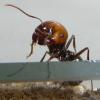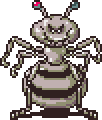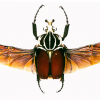@Ernteameise It's finally done!
During their endeavors antkeepers may encounter a variety of health issues their ants are struggling with.
This is a broad but not entirely comprehensive list on these problems – there are just too many specialized issues with certain uncommonly kept ants to mention them all here, and the specific requirements of many of those species are also still poorly understood.
1. Antkeeping issues
This chapter is about problems that can arise due to how the ants are handled, kept and fed.
1.1 Care issues
Inadequate care can lead to a number of problems mostly affecting the growth of a colony.
- Disturbance
Ants do not like to be disturbed. Broad daylight suddenly shining into the nest usually means the nest has been broken up by some disaster or a hungry predator and the ants must fight for the continued existence of their colony.
Single queens are exceptionally vulnerable to this and will often eat their brood if disturbed too often (Camponotus and Messor queens in particular have a reputation for eating all of their eggs when checked too frequently) but also small colonies of more sensitive species (Harpegnathos sp) can be affected very badly.
Generally single queens and small colonies should only be checked once a week, very sensitive queens are better left alone for a full month.
Ants also generally don’t like strong vibrations. Queens again are the most sensitive and should be kept in a test tube/nest in a place that experiences as few vibrations as possible – like high up on a shelf or in a rarely used drawer. Putting a towel under the test tube can act as a buffer against ground vibrations. If you have an extremely sensitive queen you should refrain from playing very loud music as well, at least until she has her first workers.
Over time colonies will get used to reoccurring vibrations like people walking around in the room, machines running and even loud music.
- Trash buildup
While ant setups do not have to be perfectly clean, larger trash piles should regularly be removed, especially the ones with food leftovers, as they are perfect breeding grounds for all sorts of nasty things. Roaches and crickets can also smell particularly bad if the ants didn’t fully eat them out.
Larger chunks (like the dorsal shell of a roach or the hollowed-out thorax of a locust) can be removed with pincers or forceps. Smaller debris is easily picked up with a flat brush, 20mm width (size 20) is about perfect. More settled piles may require the use of a spoon.
Piles that consist mostly of discarded cocoon hulls are of less consideration as they offer no food for mites or mold, however they often double up as ant toilets and thus should be removed when they grow too big or start to smell bad.
- Lack of hibernation
This is one of the more common pitfalls for inexperienced antkeepers. Most ants from temperate and subpolar climate zones experience some sort of winter hibernation (it is not technically hibernation, but the term has more or less established itself in the antkeeping community – the correct term is diapause).
The typical minimum duration for this diapause is 3 months, in which the ants have to experience significantly lower temperatures than usual. The specific temperature requirements roughly depend on the climate zone the ant originated from - for Mediterranean ants it is around 15°C, for central and northern European ants it is more like 5-10°C. Freezing temperatures are usually not required.
If the diapause period is too short or temperatures have been too high the ant colony will not properly “reset” its behavior and enter a permanent pre-diapause “standby” state which is characterized by low overall activity and little brood growth (particularly very few pupations and thus very few new workers being born), also newborn workers might be smaller than usual. The only solution is to properly hibernate the ants at the required temperatures.
- Pre-hibernation issues when heating temperate Camponotus
This is a special issue affecting large slow-growing Camponotus species from temperate regions, like C. herculeanus and C. ligniperda.
These ants essentially have a one-year-plan. The queen lays eggs in spring and in summer, and only the spring batch will develop into workers the same year - the summer batch ones will go through winter as larvae and pupate in the following spring.
If these ants are taken out of hibernation relatively early (late March/early April) and have their nest permanently heated, they may finish their year’s work very quickly and go into pre-hibernation “standby mode” as early as June.
This isn’t really a problem, you just won’t see much of your ants until after their next winter break.
You may however send them into diapause early (given you can provide a place that is cold enough) and take them out 3-4 months later. This will essentially allow you to go through two growth periods a year and accelerate their development, which is not the worst thing considering these ants grow very slowly during their first 2-3 years.
- Special behavioral patterns
Some ant species have special quirks that require specific attention. These quirks are often unique to a single genus or even just a single species, underpinning the importance of antkeepers making themselves knowledgeable about the species they keep.
One such example is summer estivation in Prenolepis imparis, the so-called “winter ant”. These ants go through a period of summer estivation and will almost entirely stop foraging when temperatures go above 25°C. They thus spend almost the entire summer underground, raising new ants purely from the reserves they built up during spring. If they were not fed properly during the colder spring days, the colony will fail to grow or may even collapse entirely. Adding food to the nest sometimes help but sadly it is not uncommon for colonies to perish.






















